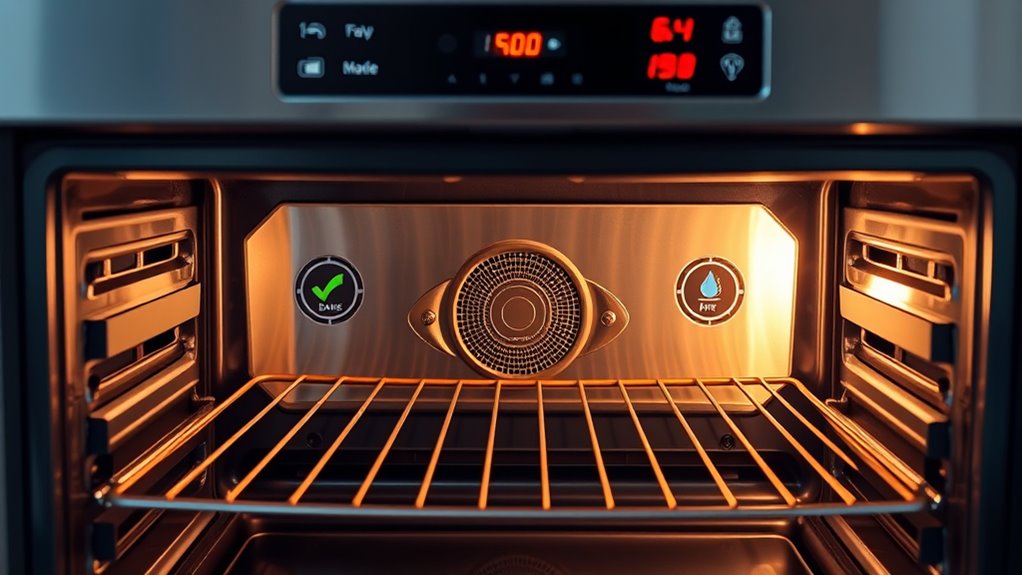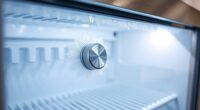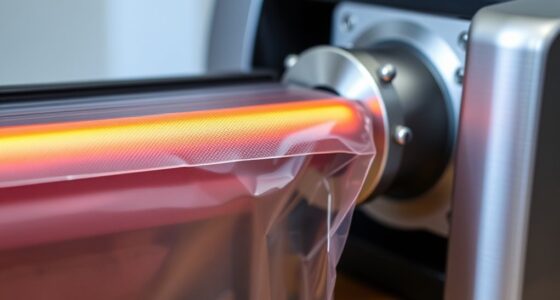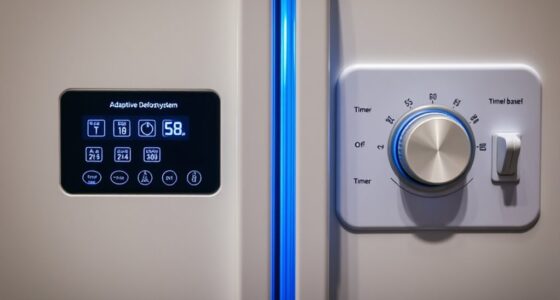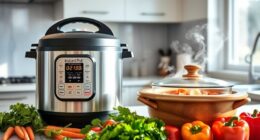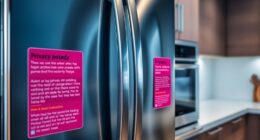Oven modes like true convection, fan bake, and air fry each serve unique purposes. True convection uses a fan plus a third heating element to circulate hot air evenly, speeding up cooking and improving result quality. Fan bake relies on existing elements without extra heating, ideal for moderate browning. Air fry uses rapid, superheated air for crispy textures with little oil. Understanding these modes helps optimize your cooking, and there’s more to discover if you keep exploring.
Key Takeaways
- True convection uses a third heating element and fan for even heat distribution and faster cooking.
- Fan bake circulates hot air with only existing elements, offering moderate browning without an additional heater.
- Air fry mode rapidly circulates superheated air to create crispy textures with minimal oil, mimicking deep frying.
- True convection provides more uniform results and quicker cooking compared to fan bake.
- Adjust oven temperatures downward by 20-25°F and reduce cooking times when using convection modes for optimal results.
Understanding True Convection and Its Advantages
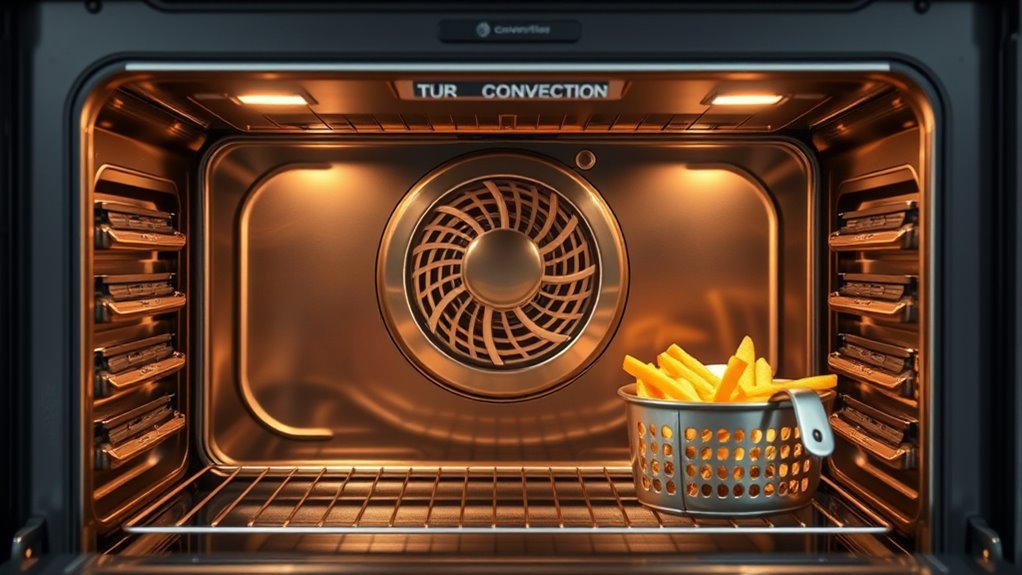
True convection, also known as European convection, uses a fan combined with a third heating element located at the back of the oven to circulate heated air evenly. This design guarantees consistent temperatures and eliminates hot and cold spots, improving cooking performance. An exhaust system works alongside the fan and heater to distribute heat uniformly throughout the oven cavity. This technology differs from traditional convection ovens, which only have a fan without a third heat source or exhaust. The result is more reliable multi-rack cooking, with even browning and crisping. It also speeds up cooking times by directing heat efficiently and maintaining precise temperatures. Additionally, true convection enhances energy efficiency by reducing cooking times and heat loss. Overall, true convection offers enhanced control, consistent results, and better texture, making it a valuable feature for home cooks and professionals alike.
How Fan Bake Mode Differs From True Convection
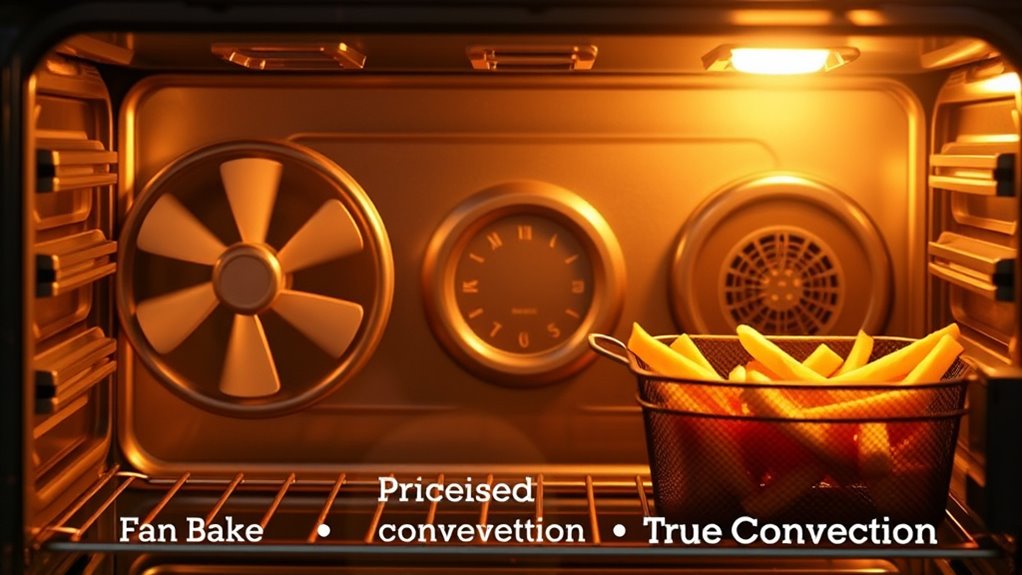
Ever wondered how fan bake mode differs from true convection? Fan bake uses a fan to circulate hot air within the oven, but it generally doesn’t include an additional heating element near the fan. Instead, it relies on the existing top and bottom heating elements to distribute heat more evenly than traditional baking. This setup is effective for many baking tasks but lacks the enhanced precision of true convection. True convection, on the other hand, features a third heating element near the fan, providing more precise and consistent heat. This extra element boosts air temperature and circulation, leading to faster, more uniform cooking. Enhanced heat distribution is one of the main advantages of true convection ovens, which often include a third heating element, enhancing heat distribution and improving cooking performance. While fan bake improves heat distribution and browning, it doesn’t match true convection’s speed or evenness. Fan bake is ideal for multiple dishes and moderate browning, whereas true convection excels at quick, even cooking for baked goods and roasted foods.
The Role and Benefits of Air Fry Mode in Modern Ovens
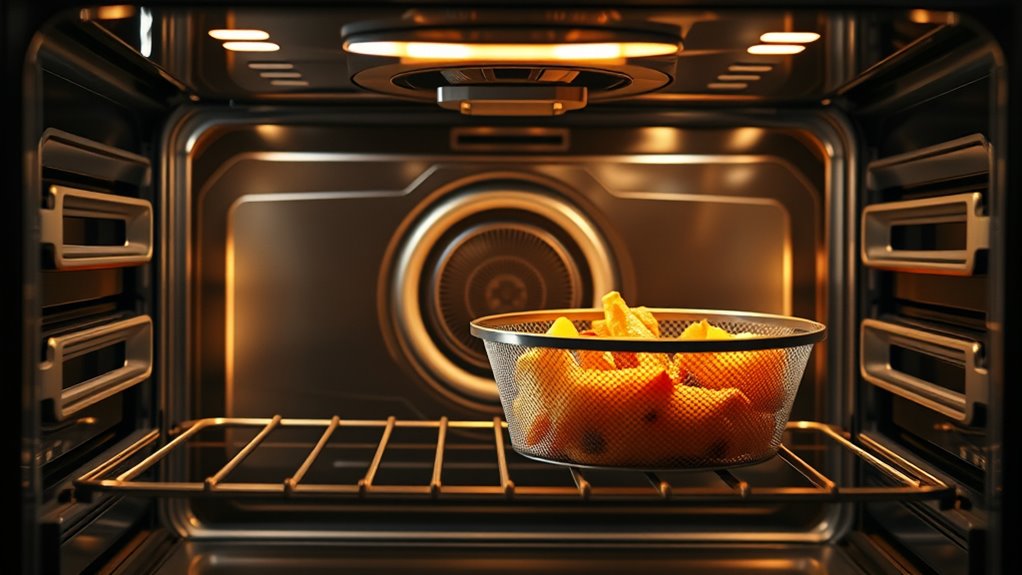
Have you noticed how air fry mode has become a popular feature in modern ovens? This setting uses rapid circulation of superheated air to produce a crispy, fried texture on all food surfaces. It mimics deep frying but uses minimal or no oil, making your meals healthier. The convection fans accelerate heat and air movement, while perforated trays ensure even exposure and crispiness. Typically operating at higher temperatures (350-400°F), air fry mode quickly delivers crunchy results. It’s versatile, suitable for vegetables, chicken wings, fries, and even baked goods. Plus, it replaces standalone air fryers, saving space and simplifying your kitchen. With easy activation and reduced cook times, air fry mode offers a convenient, healthier way to enjoy crispy foods without the mess or excess oil. Honda Tuning techniques can optimize your oven’s performance, just as they do for cars, ensuring efficient heat distribution and better cooking results. Proper oven maintenance can further enhance cooking efficiency and prolong the lifespan of your appliance.
Comparing Cooking Results: True Convection vs. Fan Bake
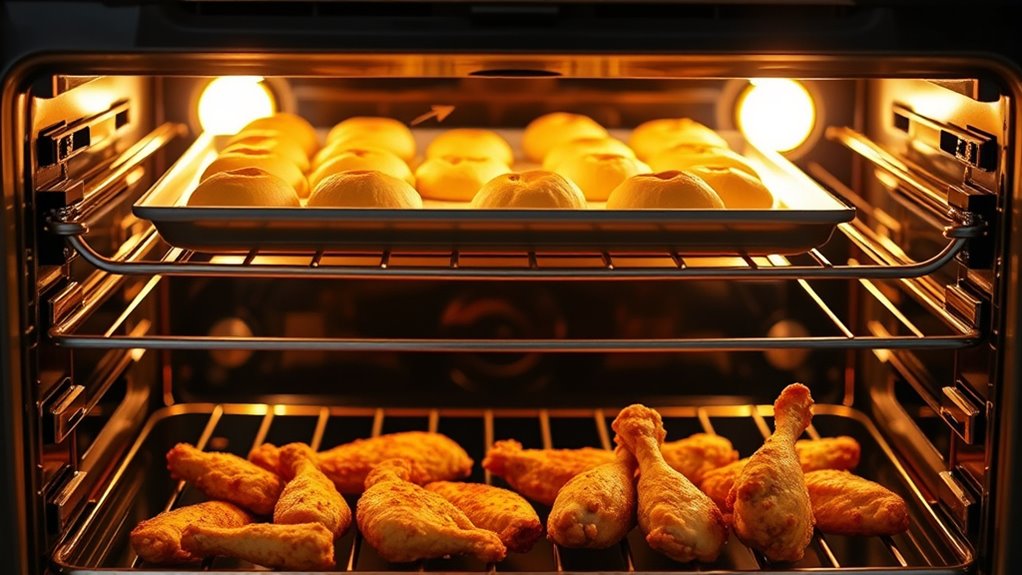
When choosing between oven modes, understanding how they affect cooking results can help you achieve the best possible outcome. True convection cooks food about 20% faster than fan bake, thanks to an extra heating element near the fan and more even heat distribution. It reduces the need to rotate dishes and yields better browning and crisping. Additionally, true convection’s heat circulation promotes more consistent cooking, especially for baked goods and roasts. Fan bake circulates hot air with a fan but lacks a dedicated heating element, often resulting in uneven heat zones and longer cook times. Here’s a comparison:
| Feature | True Convection | Fan Bake |
|---|---|---|
| Cooking Speed | ~20% faster | Slower than true convection |
| Heat Distribution | Very even, no hot spots | Can be uneven, needs repositioning |
| Browning & Crisping | Superior, quick moisture evaporation | Good but less uniform |
Additionally, understanding the heat distribution can help you select the optimal setting for different recipes. This helps you choose the best mode for your cooking goals.
Best Uses for Each Oven Mode in Daily Cooking
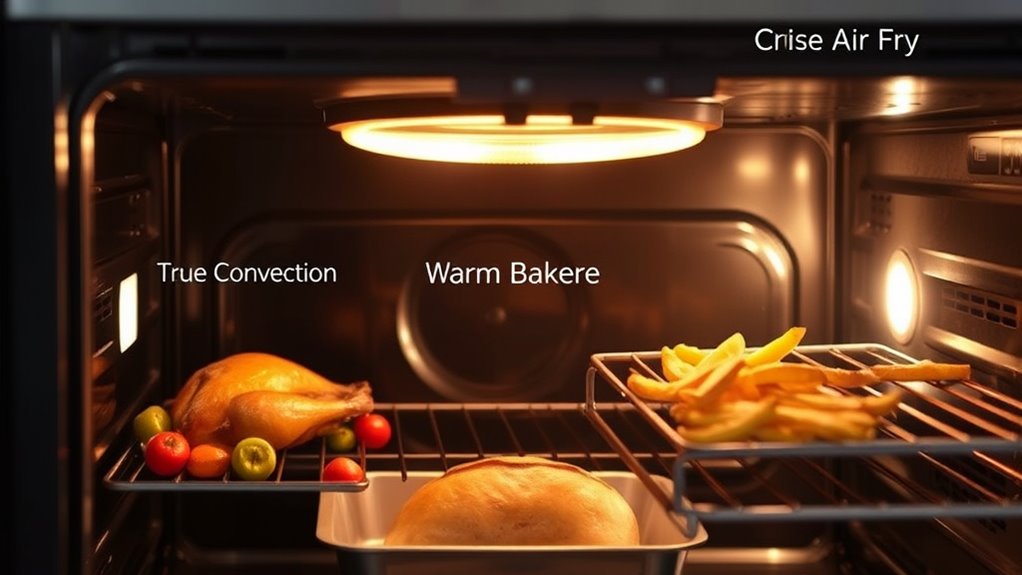
Choosing the right oven mode for daily cooking depends on your specific dish and desired results. Each mode offers unique benefits suited for different tasks.
- Use true convection when roasting large meats or baking multiple trays; it guarantees even cooking and faster times.
- Opt for fan bake for gentle, consistent heat ideal for delicate baked goods like cookies, pies, or casseroles.
- Choose air fry for quick, crispy results on smaller portions, such as chicken wings or roasted vegetables, with minimal oil.
- Incorporating tuning techniques can optimize oven performance, similar to how ECU remapping enhances vehicle efficiency, ensuring better cooking results and energy usage.
- Understanding oven modes and their specific functions can help you achieve professional-quality results at home.
True convection is perfect for thorough, crispy roasts, while fan bake suits everyday baking and gentle roasting. Air fry excels in creating crispy finishes without deep-frying, making it a versatile choice for quick, healthy meals.
Practical Tips for Optimizing Oven Mode Performance

To get the most out of each oven mode, it’s essential to optimize temperature settings and cooking times. When using convection, lower the temperature by 20-25°F to prevent overbaking and reduce cooking time by about 20-25%, checking doneness early. Use timers and delayed-start functions to save energy and prevent overcooking. Preheat dedicated air fry modes for 3-5 minutes to activate full fan speed and high heat quickly. Calibrate your oven with a thermometer to ensure accuracy, adjusting recipes if needed. Maximize airflow by arranging dishes with space between them and rotating items halfway through cooking. For even results, prefer convection modes and avoid overloading the oven. Keep the door closed during cooking to maintain consistent heat, and remember that proper maintenance can help ensure your oven operates efficiently and accurately.
Frequently Asked Questions
Can I Use All Oven Modes for Baking Bread?
Yes, you can use all oven modes for baking bread, but each offers different results. True convection speeds baking and creates a crisp crust, ideal for artisan loaves. Fan bake provides even heat with more moisture, suitable for softer bread types. Conventional bake is gentler and best for tender, moist breads. Air fry is generally not recommended, as its intense airflow can dry out or over crisp the bread. Choose the mode based on your bread type and desired texture.
How Do I Clean and Maintain the Convection Fan?
You notice that your oven’s fan runs quietly, almost like a gentle breeze, and wonder how to keep it that way. To clean and maintain the convection fan, first, turn off the power and remove the oven racks. Gently brush off grease and debris with warm water and a soft cloth. Check for damage, lubricate if needed, and run the oven at 400°F for 20 minutes to burn off residue.
Is Air Fry Mode Energy-Efficient Compared to Other Modes?
Yes, air fry mode is more energy-efficient than other modes. You’ll use less electricity because it cooks faster, thanks to a smaller cooking space and powerful fans that circulate hot air efficiently. Plus, it heats up quickly and often requires little to no preheating, reducing energy waste. Overall, using air fry mode saves you money on energy bills while providing quicker, healthier meals with less energy consumption.
Do Different Oven Modes Affect Food Nutrition?
Yes, different oven modes affect your food’s nutrition. True convection and fan bake cook faster, helping preserve heat-sensitive nutrients like vitamin C and B vitamins by reducing cooking time. Air frying uses high-speed air circulation at lower oil amounts, maintaining healthy fats and minimizing harmful compounds. Longer baking or roasting can cause nutrient loss, especially with heat-sensitive vitamins, whereas quicker, lower-temperature modes help retain more nutrients in your food.
Can I Convert Conventional Recipes for True Convection Oven Use?
Sure, you can convert conventional recipes for a true convection oven—if you’re willing to embrace some adjustments. Lower the temperature by 25°F and cut cooking time by 20-25%. It’s almost like magic, except you’re actually just smart enough to benefit from better heat circulation. Keep an eye on your food near the end, and you’ll enjoy evenly cooked, flavorful results without overdoing it.
Conclusion
Think of your oven modes as a toolbox, each designed for a specific job. Whether you’re using true convection for even baking, fan bake for crispiness, or air fry for healthier frying, knowing when and how to use them makes cooking easier—like having a secret recipe up your sleeve. Master these modes, and you’ll turn every dish into a delicious masterpiece, just as a painter expertly selects their colors for a stunning masterpiece.
